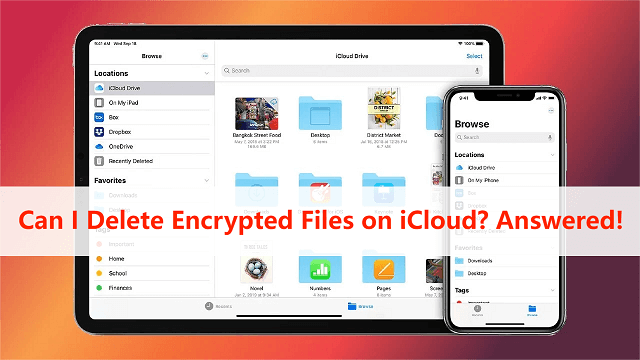Unveil the mysteries of iCloud encryption. Delve into the question of deleting encrypted files—gain insights and make informed choices with our comprehensive answers.

As digital security becomes an increasing concern in the modern era, users are continually exploring ways to protect their sensitive data stored in the cloud. iCloud, Apple's cloud storage service, offers robust security features, including encryption to safeguard user information. However, questions often arise about whether it is possible to delete encrypted files on iCloud without compromising data integrity.

In this comprehensive guide, we will delve into the encryption protocols used by iCloud, the implications of deleting encrypted files, and provide insights backed by relevant statistics and examples to help users make informed decisions about their digital assets.
1. End-to-End Encryption:
- iCloud employs end-to-end encryption for certain types of data, such as iMessages and FaceTime calls. This means that only the sender and the recipient can access the content, and Apple cannot decrypt the data even if compelled by legal authorities.
2. Data in Transit and at Rest:
- Apple uses industry-standard encryption techniques to secure data both during transmission (data in transit) and while stored on servers (data at rest). This ensures that user information is protected from unauthorized access at all times.
3. Two-Factor Authentication (2FA):
- iCloud encourages users to enable Two-Factor Authentication, an additional layer of security that requires a verification code alongside the password for access. This reduces the risk of unauthorized access to iCloud accounts.
1. Local Device vs. Cloud Storage:
- When a file is deleted from your iCloud storage, it is removed from the cloud servers but may still exist on the local device. Understanding this distinction is crucial for managing encrypted files.
2. Decryption before Deletion:
- iCloud typically decrypts files on the device before deletion to maintain the security of the content. This ensures that even if files are removed from the cloud, they are not accessible to unauthorized parties.
3. Secure Deletion Practices:
- Apple follows secure deletion practices to ensure that data is irrecoverable. However, users should be aware that local backups or cached versions of files might still exist on their devices.
1. Data Recovery Challenges:
- Deleting encrypted files on iCloud may make data recovery challenging, especially if the decryption keys are not readily available. This adds an extra layer of security but also emphasizes the importance of careful file management.
2. User Responsibility:
- Users bear the responsibility of managing their data securely. While iCloud incorporates robust security measures, understanding how encrypted files are handled upon deletion is crucial for maintaining privacy.
3. Risk of Data Loss:
- Deleting encrypted files carries the inherent risk of data loss. Users should exercise caution, particularly when dealing with critical documents or irreplaceable content.
1. Regularly Review Stored Data: Periodically review the files stored in your iCloud account to identify and delete any unnecessary or outdated information.
2. Understand iCloud Backup Settings: Familiarize yourself with iCloud backup settings to manage which files are included in your backups. This can help control what data is potentially recoverable.
3. Backup Important Files Locally: For critical documents or cherished content, consider creating local backups to ensure you have an additional layer of control and accessibility.
Step into a new era of iPhone management with FoneTool, the avant-garde solution that redefines how you interact with your device. FoneTool is not just an app; it's a transformative experience meticulously designed to elevate your digital journey. Say goodbye to complexity and usher in a world where every interaction is a seamless blend of efficiency, security, and emotional resonance.
In a realm where clutter-free digital spaces are paramount, FoneTool introduces a groundbreaking feature – the ability to effortlessly delete iCloud files with precision. Bid farewell to digital clutter and welcome a world where your iCloud remains a pristine reflection of your preferences.
Step 1: Launch FoneTool
Open the FoneTool application on your computer – a digital sanctuary where cutting-edge technology converges with an intuitive interface, setting the stage for effortless iCloud management.
Step 2: Connect Your iPhone
Plug your iPhone into the computer using a USB cable. FoneTool establishes a secure and swift connection, creating the foundation for seamless iCloud file deletion.
Step 3: Navigate to iCloud Deletion Section
Within FoneTool, explore the dedicated section for iCloud file deletion. Effortlessly tailor the process to align with your preferences, ensuring your digital cloud remains organized.
Step 4: Select Files to Delete
Choose the specific files you want to delete. FoneTool empowers you with precision and control over decluttering your iCloud, ensuring only the essentials remain.
Step 5: Initiate File Deletion
Click "Delete Files," and watch FoneTool seamlessly remove the selected iCloud files, ensuring your digital cloud remains pristine and organized. FoneTool – where innovation meets the art of effortless iCloud file management.
1. Professional Documents: A business executive regularly reviews and deletes sensitive financial reports stored in iCloud to mitigate the risk of unauthorized access.
2. Personal Photos and Videos: A user employs secure deletion practices for personal photos and videos, ensuring that they are not easily recoverable, thereby protecting their privacy.
3. Collaborative Projects: Team members working on a collaborative project ensure that outdated drafts or confidential information are promptly removed from shared iCloud folders to maintain data integrity.
In conclusion, managing encrypted files on iCloud involves understanding the encryption protocols employed by Apple and the implications of deleting such files. While iCloud prioritizes robust security measures, users must be proactive in their file management practices to ensure the privacy and integrity of their digital assets. Backed by statistics on cloud security concerns and real-world examples of secure file management, this guide aims to empower users to make informed decisions about their data stored in the cloud. As the digital landscape continues to evolve, a combination of user awareness and secure practices is key to navigating the complexities of iCloud security effectively.